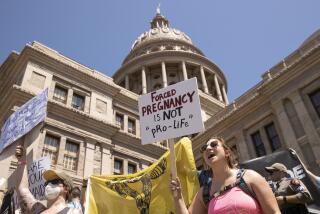Contraception, abstinence push U.S. teen birthrates to historic lows

The birthrate for American teens hit an all-time low in 2013, and government statisticians attribute the decline to a reduction in teenage sexual activity and more widespread use of birth control among those who are having sex.
Preliminary birth certificate data collected by the Centers for Disease Control and Prevention shows that 277,749 babies were born in 2013 to mothers who were under the age of 20. That is the lowest figure for any year going back to 1940, according to a report released Wednesday by researchers in the CDC’s Division of Vital Statistics. (In 1940, there were 304,004 births to American teens, the report says.)
The teen birthrate hit new lows for all age groups. There were 47.3 births for every 1,000 women ages 18 and 19; 12.3 births per 1,000 teen girls between the ages of 15 and 17; and 0.3 births per 1,000 girls ages 10 to 14. Among the 15- to 19-year-olds who accounted for nearly all teen births, the preliminary birthrate of 26.6 per 1,000 was 9.5% lower than it was in 2012.
All 50 states plus the District of Columbia recorded statistically significant declines in the teen birthrate between the years 1991 and 2012, according to the report. The size of these drops ranged from 24% in West Virginia and 25% in North Dakota to 64% in California and 65% in D.C. Overall, it was 52%.
Even when looking at the shorter period of 2007 through 2012, significant declines were recorded in D.C. and every state except West Virginia and North Dakota. These ranged from 19% in Oklahoma and South Dakota to 37% in Georgia and 39% in Colorado. Overall, the teen birthrate fell by 29% during those years.
CDC statisticians also noted that teen births dropped among young women of all racial and ethnic groups. Between 1991 and 2012, the steepest declines were seen for Asian Americans (down 64%) and African Americans (down 83%). For the most recent period between 2007 and 2012, the biggest drop was among Latina teens (down 39%).
In 2012, the most recent year with data sorted by race and ethnicity, the teen birthrates were 9.7 per 1,000 Asian Americans; 20.5 per 1,000 whites; 34.9 per 1,000 Native Americans and Alaskan Natives; and 46.3 per 1,000 Latinas.
The result of all of these declines is that the overall teen birthrate has plunged 72% since its all-time high in 1957, when there were 96.3 births per 1,000 teen girls and women. (The total number of teen births peaked in 1970, at 644,708.)
One thing that has been on the rise is the proportion of teen births to unmarried mothers. Only about 2% of American teens were married in 2013; as a result, 89% of teen births that year were to single mothers. That’s up from 48% in 1980, 15% in 1960 and 14% in 1940, according to the report.
The historically low teen birthrate appears to be a sign that efforts to prevent teen pregnancies are paying off. A 23% jump in the teen birthrate between 1986 and 1991 prompted a flurry of public and private initiatives to promote abstinence and the use of birth control, and they’re working, the CDC researchers wrote.
According to data from the CDC’s National Survey of Family Growth, the proportion of teen girls and women who are “sexually experienced” has been falling for 20 years, the report authors noted. The survey also found that more teens who are having sex are using some form of birth control, including many who use two methods, such as condoms and birth control pills or hormonal implants.
Reducing the number of teen births is good for both mothers and babies, public health experts say. Compared to older mothers, teen moms are more likely to give birth to babies who are delivered early and/or have low birth weights. Both conditions put babies “at greater risk of serious and long-term illness, developmental delays, and of dying in the first year of life,” the report authors wrote.
Babies born to teens are also at a disadvantage because their mothers are less likely to finish high school. That translates into fewer career opportunities, which “in turn compromises the resources available for her child, including food, housing, emotional support and intellectual stimulation, and so forth,” the authors wrote.
Measured in dollars, the average annual cost of these setbacks adds up to nearly $1,700 per child for the first 15 years of life, according to researchers at the National Campaign to Prevent Teen and Unplanned Pregnancy. That means the drop in the teen birthrate has saved American taxpayers billions of dollars per year (including an estimated $12 billion in 2010 alone), according to the nonprofit group.
Despite this progress, the U.S. still has a ways to go to get its teen birthrate in line with most other developed countries, the study authors wrote. The U.S. still ranks 29th among 31 developed countries (only Romania and Bulgaria are higher, with teen birthrates of 35.2 and 41.7 per 1,000 teen girls and women, respectively). Denmark, Japan, the Netherlands and Switzerland all have teen birthrates of less than 5 per 1,000, they wrote.
For more news about health and science, follow me on Twitter @LATkarenkaplan and “like” Los Angeles Times Science & Health on Facebook.







